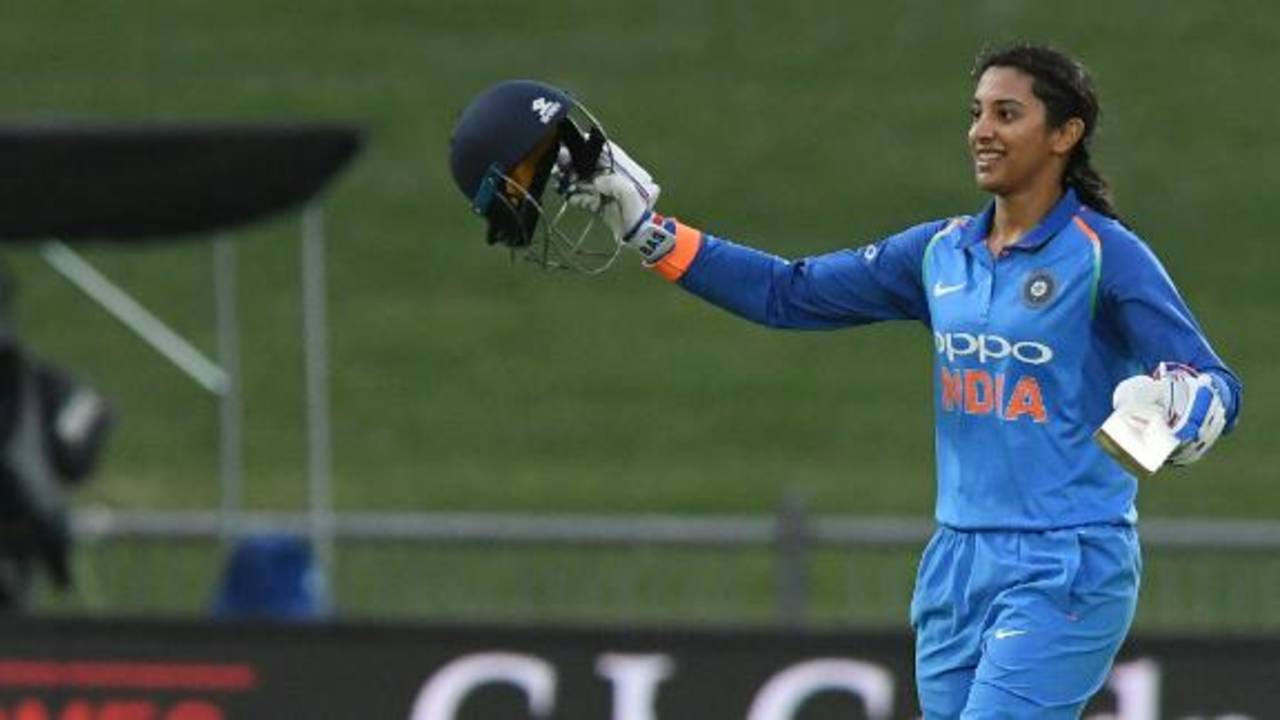Ton-up Mandhana happy to "stick in and guide the team through"
New Zealand captain Any Satterthwaite blames lack of patience with the ball, failure to stitch batting partnerships together for nine-wicket defeat
ESPNcricinfo staff
24-Jan-2019
Smriti Mandhana played the starring role with her fourth ODI century as India started their ICC Women's Championship series in New Zealand with a comprehensive nine-wicket win.
"Really happy," Mandhana said after the game. "I have a thing of getting out in the 70s and 80s, so I had to talk to myself, 'don't hit any rash shots, don't hit any lofted shots, just play in singles and doubles'. I'm really happy with that aspect. I was able to stick in and guide the team through. Again, if I'd scored three runs I would have been a lot happier (she was dismissed with India three runs short of their target)."
With only 192 to chase, Mandhana (105) and Jemimah Rodrigues (81*) knocked all but two runs off the target by themselves in a mammoth opening stand. They started cautiously, playing out the first two overs from Lea Tahuhu and Hannah Rowe before hitting a four each in Tahuhu's second over to get going.
"The wicket was really good to bat on, and initially we just played according to the merit of the ball. We just had to react to the ball, because they had good pacers," Mandhana said. "The plan was to see how the new ball was doing. This was the first time we were batting in New Zealand, and we didn't really know … we watched a bit of the men's match and also how the first innings went. So we decided to just keep it simple, play according to the merit of the ball."

Mandhana and Rodrigues added 190 runs for the first wicket•Getty Images
That still ensured India made 190 in only 32.1 overs at a run-rate of 5.87. "If we keep going, we score at a really high rate, so we don't really need to worry about the run-rate," Mandhana said. "The way we were going, I think we would have been able to chase 280-300. Anything above 260, as a batter you have it at the back of the mind … anything above 260, it would have been tough."
For New Zealand, it was a matter of starting well but then letting the momentum slip. Bates (36) and Devine (28) put on 61 runs for the first wicket but once that was broken, they struggled to put enough partnerships together. This despite captain Amy Satterthwaite (31), Amelie Kerr (28) and Rowe (25) getting good starts.
"Suzie and Sophie batted pretty well at the top, and built a bit of a platform, but we didn't get a big enough partnership at any stage of the innings (after that)" Satterthwaite said. "A lot of people got starts, 20s and 30s, and didn't kick on. There were a lot of dot balls and we created our own pressure, tried to release it with a shot that's not really on."
Then, during the Indian innings, just as there was a period where the bowlers were building pressure, a boundary would follow, almost on cue.
"Certainly with the ball, at times we weren't patient enough," Satterthwaite said. "We didn't create enough pressure and didn't string enough dot balls together, and always released it with a four ball. So you're chasing your tail constantly and that makes it pretty tough."
Highlights of India's win
- Mandhana's 105 was her fourth ODI century, putting her in second place behind Mithali Raj (seven) in the list of Indian century-makers. Harmanpreet Kaur is in third place with three.
- The 190-run stand between Mandhana and Rodrigues was the third-best for the first wicket for India in ODIs. Deepti Sharma and Punam Raut are at the top of the chart with their 320-run association against Ireland in 2017, followed by Reshma Gandhi and Raj, who had an unbroken 258-run stand against Ireland in 1999.
- Overall, it was India's fourth-best partnership in ODIs, behind the unbroken third-wicket stand of 223 between Jaya Sharma and Anjum Chopra, against Pakistan in 2005.
- The win matched India's best against New Zealand in terms of wickets - they had won by the same margin in December 2003 and in July 2015.
